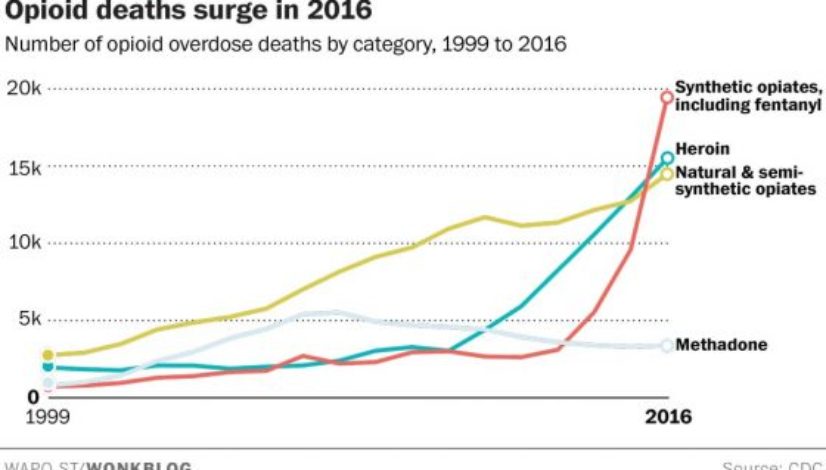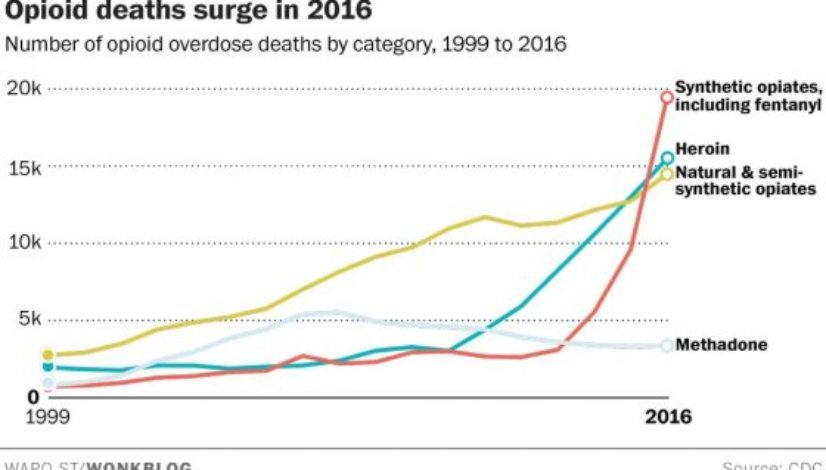Patrick Kennedy slams Trump as “all talk” after new opioid overdose figures released

Published: Dec 21, 2017, 10:47 am • Updated: Dec 21, 2017, 10:55 am
By Christopher Ingraham, The Washington Post
The national opioid epidemic escalated in 2016, driven by an unprecedented surge in deaths from fentanyl and other synthetic opiates, according to new data released Thursday by the Centers for Disease Control and Prevention.
More than 42,000 Americans died of opioid overdoses in 2016, a 28 percent increase over 2015. The number of people fatally overdosing on fentanyl and other synthetic opiates more than doubled, from 9,580 in 2015 to 19,413 in 2016. Deaths due to heroin were up nearly 20 percent, and deaths from other opiate painkillers, such as hydrocodone and oxycodone, were up 14 percent.
Overdose deaths from all drugs, including non-opioids, stood at 63,600 last year, an increase of 21 percent over the 2015 number.
“It’s even worse than it looks,” said Keith Humphreys, an addiction specialist at Stanford University. Given that research has shown that the official figures could be undercounting the true number of opioid deaths by 20 percent or more, “we could easily be at 50,000 opioid deaths last year,” Humphreys said. “This means that even if you ignored deaths from all other drugs, the opioid epidemic alone is deadlier than the AIDS epidemic at its peak.”
Robert Anderson, chief of the mortality statistics branch at the National Center for Health Statistics, which compiled the mortality data, agrees. “We’ve gone well beyond [the AIDS epidemic] now,” he said. “It’s hard to take in.”
On deaths from synthetic opioids, primarily fentanyl, “we’re talking about more than an exponential increase,” Anderson added. And while only limited provisional data is currently available for 2017, things don’t look any better. “My guess is that when all of the data are in that the [2017] trend line will be at least as steep as for 2016, if not steeper,” Anderson said.
While drug mortality has been increasing among all age groups since 1999, it’s currently highest among those age 25 to 54. Overdose rates for all drugs were roughly 35 cases per 100,000 individuals among all three groups in 2016, compared to 12 deaths per 100,000 for those under 24 and 6 deaths per 100,000 among seniors age 65 and up.
Men (26 deaths per 100,000) are about twice as likely to die of a drug overdose as women (13 per 100,000). At the state level, West Virginia stands alone as the epicenter of overdose mortality in the U.S., with 52 deaths per 100,000 residents in 2016. The two next-highest states, New Hampshire and Ohio, saw 39 deaths per 100,000.
“This is no longer an opioid crisis,” said Patrick Kennedy, a former Rhode Island congressman who was a member of President Donald Trump’s Commission on Combating Drug Addiction and the Opioid Crisis. “This is a moral crisis . . . we know how to answer this problem, but we can’t get around our own prejudices.”
Kennedy says medication-assisted therapies, including new injectable drugs that block opioid cravings, are the key to curbing the crisis. But there’s “a bias in recovery circles” against treatments like these, he says. He paraphrases it as: “‘You’re not supposed to take medications – that’s not called sobriety.’”
Related stories
- Op-ed: Trump is a no-show in the fight against opioids
- Sessions wants to put more cops on the opioid beat. Experts say that won’t solve the problem.
- How opioids started killing Americans at the corner pharmacy
- New Mexico study finds legalizing MMJ reduces opioid use
- Annual cost of opioid epidemic tops $500 billion, says White House
Beyond that, many experts say, political leaders still aren’t taking the problem seriously, and in many instances are taking steps that will make it worse. “The Trump administration’s latest proposed budget cuts the Substance Abuse and Mental Health Services Administration by $400 million,” said Stanford’s Humphreys, “and the tax bill is projected to lead 13 million people to lose health insurance and any coverage for addiction treatment along with it.”
“The Trump administration has failed the country completely in its response to the opioid epidemic,” Humphreys added.
Earlier this year, President Trump’s opioid commission recommended that the crisis be declared a national emergency, a designation that could have made emergency funding available. But in October, the president instead declared a public health emergency around the crisis, an announcement that carried no promise of additional funding.
Kennedy, who served on the commission, is critical of White House efforts so far. “He gave a fantastic speech,” Kennedy said. “But so far he’s all talk and no follow-through.”
The political dithering is costing American lives, Kennedy said – 174 deaths from drug overdoses every day in 2016, one every 8 1/2 minutes.
“Right now everybody says it’s happening to somebody else’s family,” Kennedy said. But if the current trends continue, “soon it will be happening to everybody’s family.”
Topics: Centers for Disease Control and Prevention (CDC), donald trump, opioid epidemic, Patrick Kennedy





